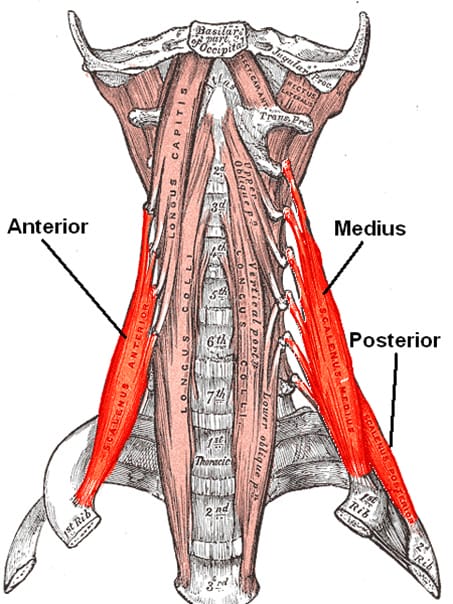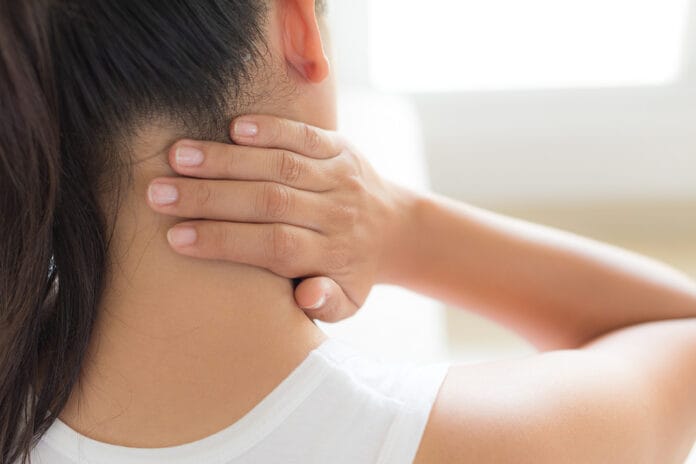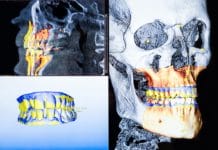The scalene muscles can either be a dental hygienist’s friend or nemesis. When the muscles are healthy, they keep the neck positioned correctly, tilt the head side to side, and turn the head left or right. When they are an adversary, the scalene muscles can feel disabling to the upper extremities.
Scalene muscles are affected by the postures of working dental hygienists, and the symptoms of pain are discussed below. Self-treatment options for dental hygienists are also mentioned.
Ideally, scalene muscles are meant to be relaxed and off duty. They are non-postural and fast-twitching muscles (meaning they fatigue quickly). When scalene muscles are overburdened, muscle fibers tighten and accrue waste products to cause neck stiffness, soreness, and limited range of motion. The scalene muscles are the most common muscles related to neck pain. When the scalene muscles are very tight, they send trigger points to the head, jaw, cheek, and behind and above the eye. They can cause tension headaches and can pull the first rib upwards.
Locations and Purposes of Scalene Muscles
Scalene muscles are of differing lengths and located laterally on each side of the neck. The scalene muscles fill in the space between the collarbone, trapezius, and sternocleidomastoid muscles. Scalene muscles are a group of three muscles and are referred to as the scalene triangle or anatomical Bermuda triangle.1
Some information about this group of scalene muscles includes the following:
Anterior scalene muscles (also called scalenus anterior) ─ These are lateral neck muscles placed deep behind the sternocleidomastoid muscle. They originate at the third, fourth, fifth, and sixth cervical vertebra and are attached by a narrow, flat tendon on the inner border of the first rib and the upper surface of the second rib (see Figure 1).
Individually, the anterior scalene muscles’ functions are to flex and laterally bend the neck to the same side as the muscle. As a group with the middle scalene, they elevate the first rib and are accessory muscles of respiration. As tightness of the scalene muscles occur, the ability to stabilize the neck is reduced, and the increased tension limits movement.2
Middle scalene muscles (also called scalenus medius) ─ These are the longest and largest of the three lateral neck muscles and are deeply placed behind the sternocleidomastoid. They attach at the sixth cervical vertebra and are positioned along the vertebrae column, and have a broad attachment at the upper surface of the first rib (see Figure 1). Individually, the middle scalene muscles help the cervical lateral flexion and rotation movements of the neck. As a group, it helps with neck flexes and helps elevate the first rib during a strong inhalation.3
Posterior scalene muscles (also called scalenus posterior) ─ These are the smallest and the most deeply seated behind the sternocleidomastoid muscles. They originate at the lower second or third cervical vertebra and are attached by a thin tendon into the outer surface of the second rib behind the anterior scalene. (See Figure 1). Individually, it lifts the second rib and tilts the neck to the same side of the muscle. As a group, it helps to flex and rotate the neck.4

Scalenus minimus (or Sibson’s muscles) ─ This refers to another muscle in the group, but it is considered to be the most variant and less relevant. It is behind the lower portion of the anterior scalene. Some people may have the extra scalene while it occurs in about 30% of the population. If it is present, it is usually found on one side of the neck. It originates at the sixth or possibly the seventh cervical vertebrae and attaches to either the fascia of the thoracic pleura or possibly the first rib. It’s a breathing accessory muscle that elevates the first rib. It can cause pain in the upper arm, forearm, and all fingers.5
Branchial Plexus and Subclavian Artery
In relation to the scalene triangle and its naturally narrow pathway for the brachial plexus and subclavian artery to diverge within this cramped area can easily promote unwelcomed circumstances. Tightening of the scalene muscles easily compresses the nerves and arteries to cause pain, paresthesia, and circulatory problems.
The brachial plexus is a network of nerves originating from the neck, vertebras C5-T1, of the spinal cord passing behind the anterior scalene muscle then emerges between the anterior and middle scalene muscle. This nerve network provides sensory and motor nerves for the entire arm. These nerves are quite complex and progress from five roots in the neck to three trunks into six divisions, three cords, and five branches ending into the fingers (see Figure 2). As these nerves branch off and spread through the arm, it’s susceptible for many injuries to cause pain, tingling, and numbness. As it is more bundled in the neck area through the scalene muscles, any vulnerabilities in the neck area from scalene conditions can provoke an array of issues in the upper extremities.6

The subclavian artery also travels from the neck through the arm to the hand to provide blood flow. On the left side of the body, the subclavian artery arises from the aortic arch to pass through the anterior and middle scalene muscles ends at the first rib to become the axillary artery. This artery supplies the armpit area and continues down the arm to become the ulnar and radial arteries into the hands.
The subclavian artery arises from the brachiocephalic trunk on the right side to travel behind the collar and breastbone connection. It becomes an axillary artery after passing along the first rib. It then passes through the armpit area and supplies blood down the arm to become the ulnar and radial arteries to the hands. Both sides pass through the cervical pleura towards the anterior scalene muscle and through the posterior scalene muscle gap.7
Conditions Associated with Scalene Muscles
Torticollis (also called wry neck) ─ This is a condition when the neck muscles, including all the scalene muscles, are constantly contracted in a shortened position. It results in a tilted head from unilateral scalene spasms and rigidity.8
Forward head posture position (also referred to as text neck) ─ This condition is common in dentistry, sitting at a computer, driving, and basically any position where the head is forward while the shoulders are hunched over for extended periods of time. Eventually, the consequence becomes noticeable with strained muscles of the neck and worsened posture.
Anatomically the neck, shoulders, and head should be in a stacked line. Being in positions that allow the head to fall forward causes an imbalance in support of the neck muscles. The front of the neck muscles shortens, and the back neck muscles lengthen, causing overall weakness and strain.
As the scalene muscles are technically cervical flexors in a healthy atmosphere within this condition, they become cervical extensors. The anterior scalene muscles become tightened, hardened, and shortened to pull the lower cervical vertebra into an inflexible forward position.8 When the head is not in the proper position above the shoulders to keep the 12 pounds of the head from falling over, the scalene muscles must work extra.
For every inch forward the neck is compromised, it can add an extra 10 pounds of weight from the head.9 This stress accrues on the muscles and causes them to be repositioned in holding the head, resulting in constant shortening and contraction to promote tension and compression from the scalene muscles.
Breathing ─ The scalene muscles are accessory muscles for breathing. During inhalation, the scalene muscles lift the upper ribs to create a volume in the chest cavity. The scalene muscles contract to open space for the lungs to expand the thorax by lifting the top ribs. If there are any respiratory issues, the scalene muscles work harder, causing tension and tightness.10
Scalene syndrome ─ Scalene syndromes are compressions of structures around the neck area. It involves the anterior and middle scalene muscles, which become tight and squeeze the neurovascular components located between the two muscles. The condition is common with activities where the head is forward and downward (such as computer and dental work). The head forward and rounded shoulder posture is greatly affected by causing chronic shortening of the scalene muscles.
Other common conditions associated with scalene syndrome are trauma, whiplash, falls, prolonged work above the head, and consistently carrying bags on one shoulder. This can contribute to thoracic outlet syndrome.
Scalene myofascial pain syndrome ─ A common type of myofascial pain syndrome, the painful condition originates in the neck and radiates down the arm. It may be primary or secondary. Primary results from chronic overuse of the scalene muscles, poor posture, and repetitive microtrauma. Secondary conditions result from medical issues as osteoarthritis, trauma, and complex regional pain syndrome.
This condition can cause muscle weakness and stiffness to limit movement of the neck. It commonly mimics carpal tunnel syndrome and peripheral polyneuropathy.11 It is often misdiagnosed with myofascial pain syndrome, cervical disc herniation, cervical stenosis, and thoracic outlet syndrome, as these conditions are associated with neck pain that radiates down the arm.
Myofascial pain syndrome ─ Myofascial pain syndrome is a chronic regional pain associated with hyperirritable areas as the result of taut bands such as muscle knots in the skeletal muscles. This causes abnormal referred pain patterns from the affected muscle. Symptoms will include neck pain with pain radiating to the head, shoulders, and arm; extreme tenderness of the upper back and neck muscles; and unilateral neck and shoulder pain. It can be caused by a previous injury, repetitive neck movements, overuse stress, and poor posture.11 It may be associated with scalene myofascial pain.
Thoracic outlet syndrome ─ There are multiple causes of thoracic outlet syndrome, but the one associated with the scalene muscles is when the brachial plexus and subclavian artery are compressed between the anterior and medial scalene muscles. This can cause weakness, pain, tingling, and numbness of the shoulders, upper arm, elbow, forearm, hand, and fingertips.
Thoracic outlet syndrome is originally noticed with pain in the hand and fingers and continues to numbness or coldness into the forearm. It may even cause muscle weakness and atrophy of the hand and forearm. Activities that compress the subclavian artery and brachial plexus increase the symptoms, while activities that relax the scalene muscles to open the pathway decrease symptoms.12
Treatments include calming the scalene muscles by relieving tension, spasms, inflammation, and facial irritation. Massage increases blood flow and decreases inflammation. Stretching of the scalene, chest, and trapezius helps reduce inflammation and muscle spasm.
Conditions Misdiagnosed for Scalene Conditions
Cervical stenosis ─ Cervical stenosis is when the spinal canal is too small for the spinal cord and nerve roots, allowing atypical compression onto these components. Pain symptoms are felt when the head moves and is electrical and numbing, felt from the neck as it radiates down one or both arms. It is commonly a result of shortened or overgrowth of bone in the neck, an enlarged ligament in the neck, or arthritis.13
Cervical disc herniation ─ Cervical disc herniation is when a disc in the neck abnormally protrudes and presses onto the adjacent nerve root. Pain can be sharp, dull, burning, numbness, tingling, and pins and needles. The affected cervical disc depends on where the pain derives and ends. For example, a herniation at C2 will cause pain from the disc and shoot to the eye, ear, and head. On the other hand, a herniation at C5 will cause pain from the disc and shoot to the neck, shoulder, scapula, and down the arm. Not only will the pain be apparent in the neck or between the shoulder blades, but weakness may also be a contributor throughout the arms, hands, and fingers. Causes may be from age, wear and tear, trauma, poor posture, and an unhealthy lifestyle.11
Cervical radiculopathy ─ Cervical radiculopathy is more commonly known as the pinched nerve. When the scalene muscles become tight, they can narrow the brachial plexus pathway and trap a nerve, causing a pinched nerve in the neck that can be felt through the arm to the hand. The impingement is commonly at the scalene triangle. When the muscles become tight, they can pinch the structures of the nerves, arteries, and veins that pass through the area to cause burning, aching, tingling, and numbness in the arm or neck.15
Basic Facts about Scalene Muscle Pain
The locations of symptoms related to scalene muscles are the neck, chest, arm, upper back, and headaches. The space between the shoulder blades feels heavy like cement.
The most common symptoms are a pain that persists or worsens; unilateral neck and shoulder pain; muscle knots; certain trigger points that activate the pain; head or jaw pain; numbness; tingling; electric-shock; dull or sharp; and weakness.
Activities that can cause scalene muscle pain are whiplash; excessive coughing; sufferers of breathing conditions such as COPD, asthma, and emphysema; extended periods of head tilted; sleeping on stomach with head to one side; carrying something heavy such as a backpack or purse; pulling or lifting with the arms at waist level; wearing a tight collar or tie; and bad posture with hunching, forward head posture, and shoulder rounding.
Treatment
Prolonged tension weakens and reduces the function of the surrounding tissues, compromising proper posture to cause pain. Effective treatments relieving the tightness and surrounding areas of the scalene muscles include:
Stretching ─ There are many versions of stretching the scalene muscles, mainly by tilting the head towards the shoulder and the chin tuck.
Opening the chest ─ Tight chest muscles cause slouching and pull on the neck muscles.
Hydration ─ Water helps the soft tissues move and maintain flexibility.
Breaks ─ If crouched over for extended periods of time, the fatigue can weaken the muscles.
Sleeping in a neutral position ─ Using a proper pillow and not too high or too low causes the scalene muscles to extend or flex.
Massage ─ When the scalene muscles are massaged, it relieves the tension and can relieve pain in the head, chest, back, and arm.
Trigger points therapy ─ Scalene muscles offer effective trigger points to release pain from the neck to the fingertips.
Scalene muscles are multifactorial on their own and contribute to other complications. Overworked and fatigued scalene muscles will cause multiple areas of pain in the proximity or distantly. They are tricky as it may be challenging to determine the source of the pain precisely. Symptoms of scalene muscle conditions are basically pain, and referred pain is commonplace. Other parts of the body may feel intense pain, leading to a belief that those areas are the cause of the condition rather than the scalene muscles. Tight scalene muscles may present as a numbed hand when the cause is actually a tight neck. So being aware and treating scalene muscles may help resolve other pains.
Need CE? Click Here to Check Out the Self-Study CE Courses from Today’s RDH!
Listen to the Today’s RDH Dental Hygiene Podcast Below:
References
- Martin, D. (n.d.). Scalene Muscles: Neck, Shoulder, Chest, Upper Back, Arm, Pain. The Wellness Digest. https://thewellnessdigest.com/scalenus-anterior-medius-posterior-muscles-neck-shoulder-chest-upper-back-arm-pain/
- Anterior Scalene. (n.d.). Physiopedia. https://www.physio-pedia.com/Anterior_Scalene
- Middle Scalene. (n.d.). Physiopedia. https://www.physio-pedia.com/File:Scalenus_medius_muscle_-_animation02.gif
- Posterior Scalene. (n.d.). Physiopedia. https://www.physio-pedia.com/Scalenus_Minimus
- Scalenus Minimus. (n.d.). Physiopedia. https://www.physio-pedia.com/Scalenus_Minimus
- Sendic, G. (2023, November 3). Brachial Plexus. Ken Hub. https://www.kenhub.com/en/library/anatomy/brachial-plexus
- Sieroslawska, A. (2023, October 30). Subclavian Artery: Regional Approach and Mnemonic. Ken Hub. https://www.kenhub.com/en/library/anatomy/the-subclavian-artery
- Asher, A. (2022, November 22). Very Well Health. https://www.verywellhealth.com/what-makes-the-scalene-muscles-tight-4062171
- The 40 Pound Head – Damaging Effects of Forward Head Posture. (2016, October 24). Orthotropics. https://orthotropics.com/the-40-pound-head-damaging-effects-of-forward-head-posture/
- Ingraham, P. (2018, June 13). Massage Therapy for Neck Pain, Chest, Pain, Arm Pain, and Upper Back Pain. Pain Science. https://www.painscience.com/articles/spot-04-scalenes.php
- Jalil, N.A., Awang, M.S., Omar, M. Scalene Myofascial Pain Syndrome Mimicking Cervical Disc Prolapse: A Report of Two Cases. Malaysian Journal of Medical Sciences. 2010; 17(1): 60-66. https://www.ncbi.nlm.nih.gov/pmc/articles/PMC3216145/
- Thoracic Outlet Syndrome Causes and Treatments for Hand Tingling or Numb at Night.(n.d.). Alpha Chiropractic and Physical Therapy. https://robertsonfamilychiro.com/thoracic_outlet_syndrome_cause_treatment_for_hand_going_asleep_numb_at_night.htm
- Cervical Stenosis. (n.d.). University of Virginia School of Medicine. https://med.virginia.edu/neurosurgery/services/spine-surgery/cervical-stenosis/
- Park, D.K., Rodway, I. (2020, August). Cervical Radiculopathy (Pinched Nerve). OrthoInfo. https://orthoinfo.aaos.org/en/diseases–conditions/cervical-radiculopathy-pinched-nerve/












